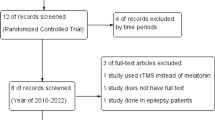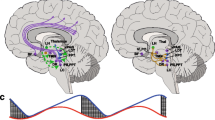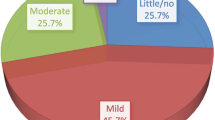Abstract
The pineal gland and its secretory product, melatonin, have been implicated in the pathophysiology of migraine, as well as some of its comorbid disorders. Supporting this view, many migraineurs are susceptible to various environmental triggers that influence the secretion of melatonin from the pineal gland, and many prodromal symptoms are probably generated in the hypothalamus, a brain region that provides input into the pineal gland to modulate the secretion of melatonin. In addition, studies have shown abnormalities in melatonin secretion in patients who experience migraine and an improvement in migraine following administration of melatonin. However, the dysfunction in melatonin secretion in migraineurs may simply be a marker of hypothalamic dysfunction or neuronal hyperexcitability, leading to migraine susceptibility. It is also possible that abnormal melatonin secretion leads to decreased inhibitory neurotransmitter activity, decreased inhibition of the release of calcitonin gene-related peptide (CGRP) from activation of the trigeminal system, or less analgesia.
Whatever its role in the pathogenesis of migraine, melatonin may prove to be a useful therapy. Future studies are necessary to further elucidate whether melatonin is a well tolerated, beneficial therapy, and to determine the optimal dose and formulation of melatonin for use in migraine therapy.
Similar content being viewed by others
References
Brun J, Claustrat B, Saddier P, et al. Nocturnal melatonin excretion is decreased in patients with migraine without aura attacks associated with menses. Cephalalgia 1995; 15: 136–9
Peres MF. Melatonin, the pineal gland and their implications for headache disorders. Cephalalgia 2005; 25: 403–11
Zurak N. Role of the suprachiasmatic nucleus in the pathogenesis of migraine attacks. Cephalalgia 1997; 17: 723–8
Silberstein SD. Advances in understanding the pathophysiology of headache. Neurology 1992 Mar; 42(3 Suppl. 2): 6–10
Ramadan NM. Targeting therapy for migraine: what to treat? Neurology 2005 May 24; 64(10 Suppl. 2): S4–8
Macchi MM, Bruce JN. Human pineal physiology and functional significance of melatonin. Front Neuroendocrinol 2004; 25: 177–95
Moller M, Baeres FMM. The anatomy and innervation of the mammalian pineal gland. Cell Tissue Res. 2002 Jul; 309(1): 139–50
Peres MF, Sanchez del Rio M, Seabra MLV, et al. Hypothalamic involvement in chronic migraine. J Neurol Neurosurg Psychiatry 2001; 71: 747–51
Perreau-Lenz S, Kalsbeek A, Van Der Vliet J, et al. In vivo evidence for a controlled offset of melatonin synthesis at dawn by the suprachiasmatic nucleus in the rat. Neuroscience 2005; 130(3): 797–803
Peres MF, Stiles MA, Oshinsky M, et al. Remitting form of hemicrania continua with seasonal pattern. Headache 2001 Jun; 41(6): 592–4
Gimeno MF, Landa A, Sterin-Speziale N, et al. Melatonin blocks in vitro generation of prostaglandin by the uterus and hypothalamus. Eur J Pharmacol 1980 Apr 4; 62(4): 309–17
Nagtegaal JE, Smits MG, Swart ACW, et al. Melatonin-responsive headache in delayed sleep phase syndrome: preliminary observations. Headache 1998; 38: 303–7
Reiter RJ, Calvo JR, Karbownik M, et al. Melatonin and its relation to the immune system and inflammation. Ann N Y Acad Sci 2000; 917: 376–86
Chuang JI, Mohan N, Meltz ML, et al. Effect of melatonin on NF-kappa-B DNA-binding activity in the rat spleen. Cell Biol Int 1996 Oct; 20(10): 687–92
Viswanathan M. Melatonin inhibits calcitonin gene-related peptide-induced vasodilation and increase in cAMP in rat middle cerebral arteries. Eur J Pharmacol 2001; 415: 247–50
Tom B, De Vries P, Heiligers JPC, et al. The lack of vasoconstrictor effect of the pineal hormone melatonin in an animal model predictive of antimigraine activity. Cephalalgia 2001 Jul; 21(6): 656–63
Doolen S, Krause DN, Dubocovich ML, et al. Melatonin mediates two distinct responses in vascular smooth muscle. Eur J Pharmacol 1998 Mar 12; 345(1): 67–9
Wang F, Li JC, Wu CF, et al. Hypnotic activity of melatonin: involvement of semicarbazide hydrochloride, blocker of synthetic enzyme for GABA. Acta Pharmacol Sin 2002 Sep; 23(9): 860–4
Li S, Wang T, Wang R, et al. Melatonin enhances antinociceptive effects of δ-, but not (μ-opioid agonist in mice. Brain Res 2005; 1043: 132–8
Shavali S, Begonia H, Govitrapong P, et al. Melatonin exerts its analgesic actions not by binding to opioid receptor subtypes but by increasing the release of β-endorphin an endogenous opioid. Brain Res Bull 2005; 64: 471–9
Castro LM, Gallant M, Niles LP. Novel targets for valproic acid: up-regulation of melatonin receptors and neurotrophic factors in C6 glioma cells. J Neurochem 2005 Dec; 95(5): 1227–36
Claustrat B, Loisy C, Brun J, et al. Nocturnal plasma melatonin levels in migraine: a preliminary report. Headache 1989 Apr; 29(4): 242–5
Murialdo G, Fonzi S, Costelli P, et al. Urinary melatonin excretion throughout the ovarian cycle in menstrually related migraine. Cephalalgia 1994; 14: 205–9
Claustrat B, Bran J, Geoffriau M, et al. Nocturnal plasma melatonin profile and melatonin kinetics during infusion in status migrainosus. Cephalalgia 1997; 17: 511–7
Salvesen R, Bekkelund SI. Migraine, as compared to other headaches, is worse during midnight-sun summer than during polar night: a questionnaire study in an arctic population. Headache 2000; 40: 824–9
Claustrat B, Bran J, Chiquet C, et al. Melatonin secretion is supersensitive to light in migraine. Cephalalgia 2004; 24: 128–33
Micromedexs R. Melatonin: Drugdex evaluations. Micromedex® Healthcare Series [online]. Available from URL: http://www.Thomson.hc.com [Accessed 2005 Dec]
Aldhous M, Franey C, Wright J, et al. Plasma concentrations of melatonin in man following oral absorption of different preparations. Br J Clin Pharmacol 1985 Apr; 19(4): 517–21
Tzischinsky O, Lavie P. Melatonin possesses time-dependent hypnotic effects. Sleep 1994 Oct; 17(7): 638–45
Peres MF, Zukerman E, da Cunha Tanuri F, et al. Melatonin, 3mg, is effective for migraine prevention. Neurology 2004 Aug 24; 63(4): 757
Kato K, Hirai K, Nishiyama K, et al. Neurochemical properties of ramelteon (TAK-375), a selective MT1/MT2 receptor agonist. Neuropharmacology 2005; 48: 301–10
Dubocovich ML, Rivera-Bermudez MA, Gerdin MJ, et al. Molecular pharmacology, regulation and function of mammalian melatonin receptors. Front Biosci 2003; 8: D1093–108
Acknowledgements
The authors received no funding to prepare this review and have no conflicts of interest directly relevant to its content.
Author information
Authors and Affiliations
Corresponding author
Rights and permissions
About this article
Cite this article
Vogler, B., Rapoport, A.M., Tepper, S.J. et al. Role of Melatonin in the Pathophysiology of Migraine. CNS Drugs 20, 343–350 (2006). https://doi.org/10.2165/00023210-200620050-00001
Published:
Issue Date:
DOI: https://doi.org/10.2165/00023210-200620050-00001




